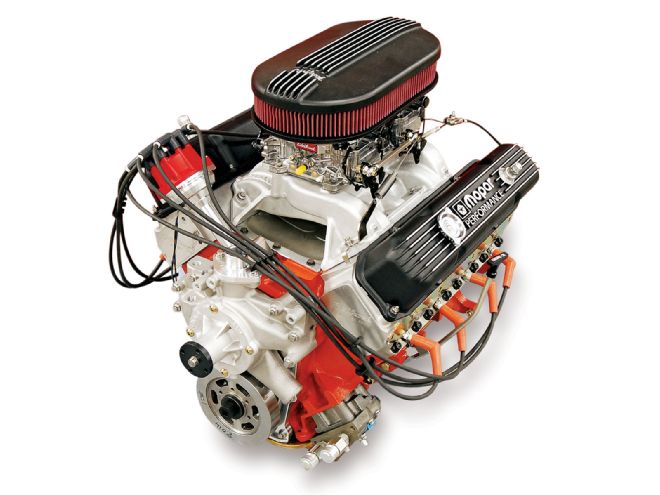
Big-block Mopar engines have been a popular choice for the street performance crowd for a long time, but until recently the aftermarket support was a little sparse. All of that started to change with the introduction of the Edelbrock RPM Performer cylinder heads and then the release of low-cost stroker kits. These days, it doesn't cost much more to build a 500-inch Mopar than it does to rebuild a 440. This 505ci engine was designed to showcase some serious street/strip muscle with an old-school dual-quad look. A combination of a stroker kit with a retro-fit hydraulic-roller cam, aluminum heads, and the CH-28 intake manifold fit the bill perfectly.
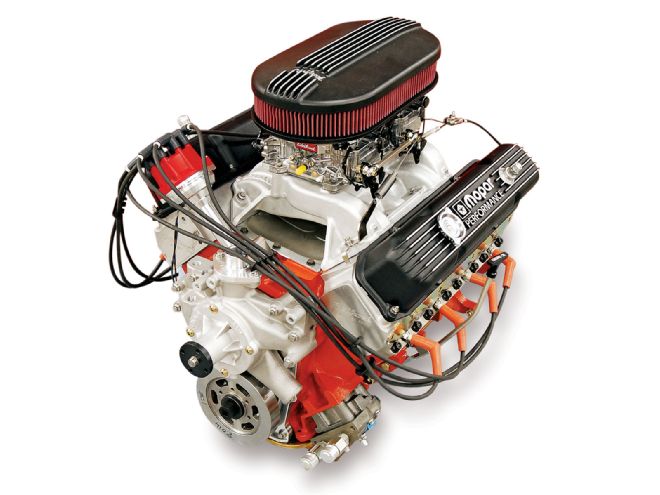
Short-Block
This engine was destined for a street car, so the original 440 block was reused after passing a careful inspection and sonic check. Aftermarket engine blocks are available for the big Mopar, but they aren't really necessary at this power level. A wide selection of stroker pistons is available at a 4.375 bore size, but that would have required boring the block .055-over. Because we wanted to keep the cylinder walls as thick as possible for future rebuilds, we just went .030-over to a final bore size of 4.350.
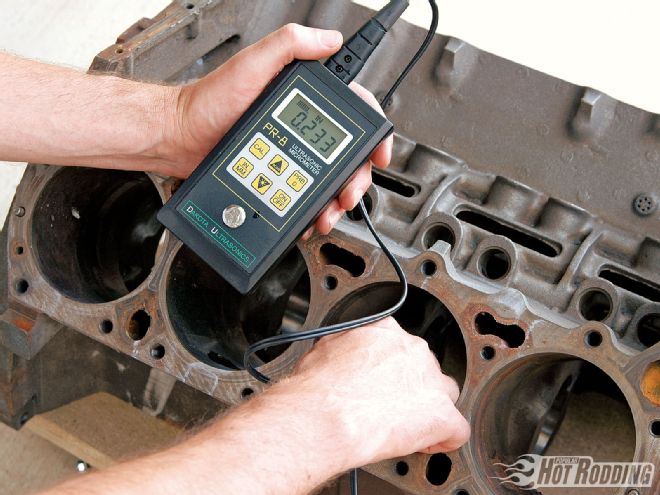 The 505 Mopar Wedge engine build started with a block from a '74 passenger car. The block was sonic checked and magnafluxed before starting the machine work.
The 505 Mopar Wedge engine build started with a block from a '74 passenger car. The block was sonic checked and magnafluxed before starting the machine work.
The very first Mopar stroker motor that I built back in the '80s used a factory crankshaft with welded and reground rod journals. That old crank stayed together for a number of years, but today, high-quality forged stroker cranks are available right off the shelf. For this engine a 4.250 stroke crankshaft was purchased from 440Source. Other vendors, such as Callies, Eagle, SCAT and K1, also have Mopar stroker cranks in stock so there is a wide selection available these days.
We selected a crankshaft with 2.200-inch diameter rod journals so we could use Chevy big-block connecting rods. Using Chevy rods in a Mopar engine might seem odd, but there are a lot more Chevy rods on the market than Mopar rods, so they are a very cost-effective part to use. The Chevy rods are also available in a wide range of lengths, which gives the engine builder some additional choices to work with. Using a Chevy rod also lets an engine builder use the more common 2.200-inch rod bearings and the lighter 0.990 diameter piston pins.
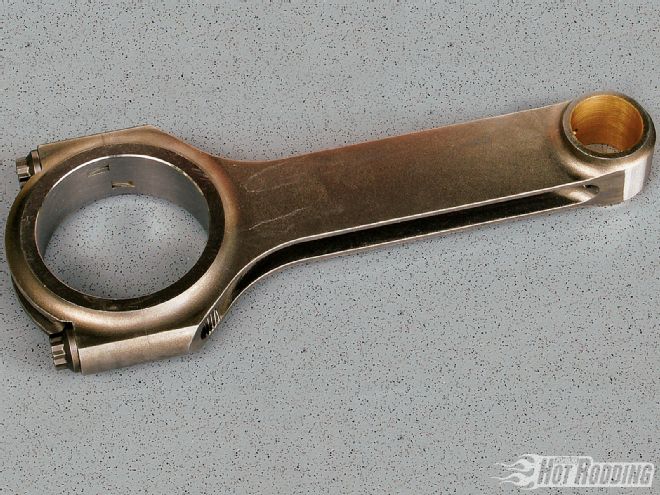 Our connecting rods are SCAT big-block Chevy H-beam rods. These rods are 6.800 inches long, but the Mopar block is tall enough to accept rods as long as 7.100 inches.
Our connecting rods are SCAT big-block Chevy H-beam rods. These rods are 6.800 inches long, but the Mopar block is tall enough to accept rods as long as 7.100 inches.
We went with a set of 6.800-inch-long Chevy H-beam rods from Scat. These H-beam rods are priced very fairly, and they have an excellent reputation for motors in this power range. The 6.800 rods fit just fine in a Mopar block with the 4.250 stroke because of the tall 10.72-inch Mopar deck height. Even with the long Chevy rods, the Mopar block is tall enough that there is plenty of room for a full-length piston with a very conservative ring package.
With the closed-chamber Edelbrock heads, a flat-top piston in a 500-inch Mopar makes approximately 11:1 compression, which is near the limit that can be run with today's pump gas. For this particular motor we were willing to run race gas, so Diamond pistons with a small 5cc dome were custom ordered. The final compression ratio is right at 12.5:1 when the Edelbrock heads are installed with thick Fel-Pro head gaskets. The extra compression pumps up the power curve, but down the road we might regret this choice if high-octane gas becomes harder to find.
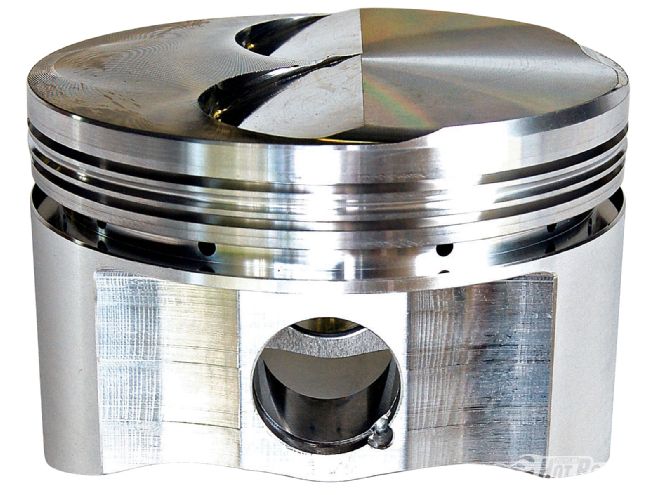 Diamond Racing has shelf pistons for a 4.250-inch stroke Mopar big-block with 6.800-long Chevy rods. We ordered our pistons with a 5cc dome in order to raise the compression to 12.5:1.
Diamond Racing has shelf pistons for a 4.250-inch stroke Mopar big-block with 6.800-long Chevy rods. We ordered our pistons with a 5cc dome in order to raise the compression to 12.5:1.
Edelbrock Heads
Mopar big-block engines all came from the factory with cast-iron cylinder heads. While a couple versions of the factory head are regarded as decent choices, we didn't want to spend time repairing 40-year-old castings when good alternatives exist. One of those alternatives is the very popular Edelbrock Performer RPM head. These Edelbrock heads are aluminum, which saves more than 40 pounds off the nose of the car, and they have a modern combustion chamber with good quench. The closed combustion chambers in the Edelbrock heads measure 84 cc, and they come with oversized 2.14-inch intake and 1.81-inch exhaust valves.
After receiving the heads, we sent them to Porter Racing Heads for some minor porting and blueprinting. While the Edelbrock heads can be run out of the box, we prefer to pull them down to double check guide clearances, lap in the valves, and give everything a close inspection before spending a lot of time on the dyno at wide open throttle. These Performer RPM heads have the same small port size as stock heads, but they flow quite a bit more air. The Edelbrock heads flow 290 cfm on the intake at .600-inch lift right out of the box. The porting work by PRH picked up the flow to just a little over 300 cfm on the intake at .600 lift, which we felt should be good for about 600 hp if everything else is properly tuned.
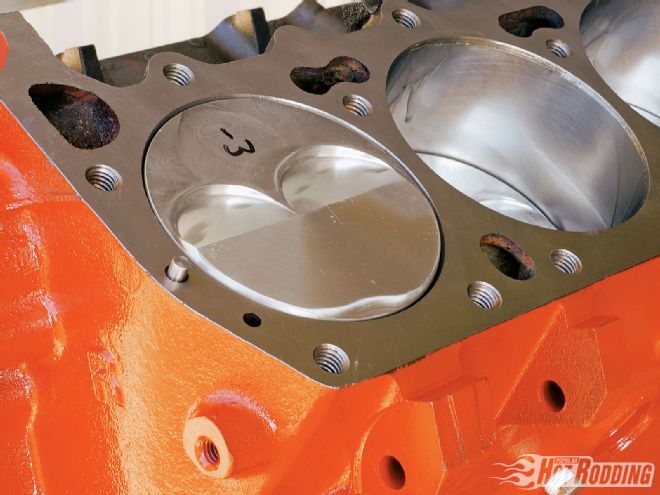 The pistons were set with the flat portion very close to the deck surface in order to optimize the quench. The number written on the piston shows that this piston is 0.003 down from the deck at TDC.
The pistons were set with the flat portion very close to the deck surface in order to optimize the quench. The number written on the piston shows that this piston is 0.003 down from the deck at TDC.
Mopar big-block cylinder heads have two basic port sizes, standard and Max Wedge. These Edelbrock heads are the smaller, standard port size, which has a cross section of 2.88 square inches. The classic McFarland formula tells us that a 505ci engine with 2.88 square-inch cross-sectional heads will have a torque peak near 4,000 rpm. We always double-check our engine designs with the McFarland formula, and it is usually pretty good at predicting the actual results.
As with most aftermarket heads, the spark plugs in the Edelbrock RPM heads are angled, which can cause some fitment issues. Many header designs have been updated to fit the newer head designs, but older headers might require clearance work. As with most aluminum cylinder heads, a 3/4-inch reach spark plug is required.
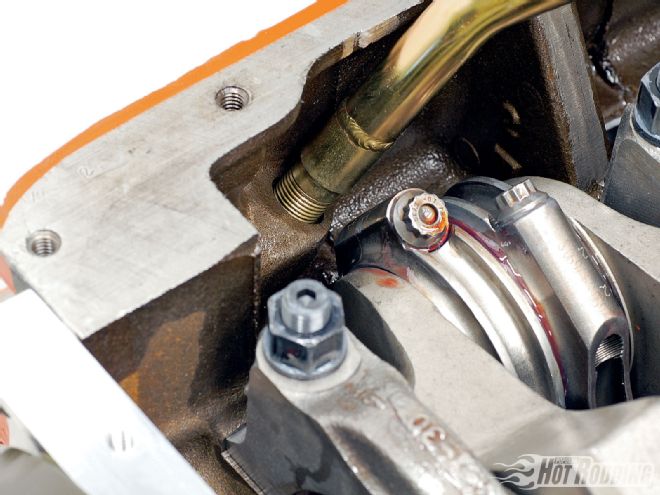 Using the Chevy connecting rods frees up a little space in the crankcase due to the smaller rod journal size. Even with the big 4.250 stroke crankshaft, the connecting rods clear the oil pump inlet just fine.
Using the Chevy connecting rods frees up a little space in the crankcase due to the smaller rod journal size. Even with the big 4.250 stroke crankshaft, the connecting rods clear the oil pump inlet just fine.
Cam and Valvetrain
We knew that the size of the cylinder head ports would limit the power peak to less than 6,000 rpm, so a decision was made to go with a hydraulic-roller camshaft. Big-block Mopar engines never came from the factory with hydraulic-roller camshafts, but the aftermarket has stepped in to develop retro-fit parts. COMP Cams is one of those vendors with retro-fit parts for the Mopar big-block, including a line of Xtreme Energy hydraulic-roller camshafts that use their new XFI lobe family. For this engine, we went to the bottom of the page, and selected the XR292HR-10, which is the largest hydraulic-roller cam COMP had in the catalog. The XR292 has an advertised duration of 292/300, and a .050 duration of 242/248. The COMP catalog says this cam will have a radical idle but in our 505-inch engine the idle was actually quite mellow.
To complement the big roller cam, we selected a set of 1.60-ratio stainless steel rocker arms from Rocker Arm Specialist (RAS). These rocker arms aren't very well known in the Mopar world, but they are a great product that we have used over the years in different motors. The RAS rocker arms come complete with heavy-duty shafts and hold-downs as well as high-quality adjuster hardware. These stainless rocker arms have a roller tip and a bronze bushing for the shaft. The 1.60 rocker arm ratio gave us a total valve lift of .584/.579 on the intake and exhaust. A set of COMP 26120-16 beehive valve springs was selected based on excellent results in the past with similar combinations. These beehive springs have been shown to work well with the XFI cam lobes on other projects, so we felt comfortable with this choice.
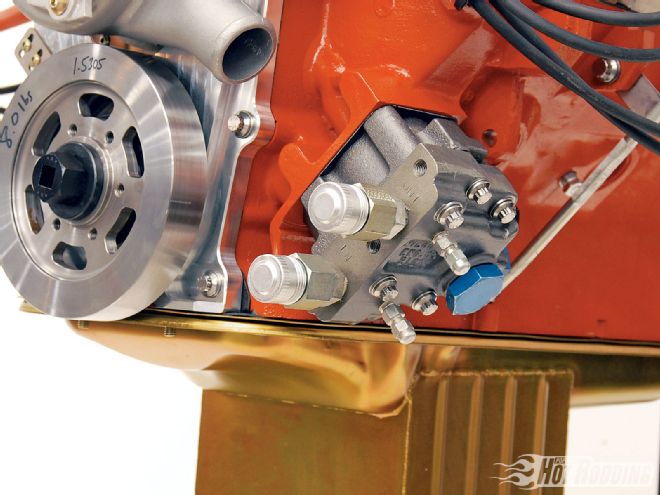 An extra deep windage tray from Milodon was required to clear the long stroke. This tray is PN 32005, and will clear strokes up to 4.50 inches.
An extra deep windage tray from Milodon was required to clear the long stroke. This tray is PN 32005, and will clear strokes up to 4.50 inches.
Intake and Carb
We have wanted to get a healthy big-block Mopar with this CH-28 dual-carb intake on the dyno for some time. The CH-28 intake is an old favorite from Edelbrock that has been around for many years. It is a low-profile dual-plane intake, so it isn't going to make killer power, but it looks great, and we thought it might just run pretty hard on the right engine. Edelbrock has linkage kits, air cleaners, and fuel lines available, while Hughes Engines offers a porting package for this intake. Hughes Engines also has a linkage kit designed to work with the stock Mopar throttle cable, which makes this intake a bolt-in deal for many Mopar muscle cars.
The CH-28 intake is designed with a tight 6 7/16-inch center-to-center spacing and the narrow 4 1/4-inch bolt pattern, so carburetor choices are limited to the AFB or AVS. Of course, a pair of original Carter carbs would look just perfect on a classic Mopar engine, but since Carter carbs are no longer available we opted for a pair of the very similar looking Edelbrock AVS Thunder Series carbs. We used a pair of PN 1804 carbs, which are rated at 500 cfm and are calibrated by Edelbrock for dual-quad applications. Edelbrock actually recommends a pair of the slightly larger 600-cfm carbs for a 500ci engine, so it is possible that we left a little power on the table.
 The oil pump is a standard replacement unit, but the Milodon cover is designed for use with external oil lines. We use this cover for dyno testing because the dyno cell is equipped with a remote oil filter.
The oil pump is a standard replacement unit, but the Milodon cover is designed for use with external oil lines. We use this cover for dyno testing because the dyno cell is equipped with a remote oil filter.
On the Dyno
The first order of business on the dyno was to check the cranking compression. We always check the cranking compression on new combinations in order to give us a baseline that we can keep track of over time. We considered it a good omen when all eight cylinders cranked right at 225 psi with very little variation between them. Our plan was to run all tests with the ignition timing at 36 degrees of advance, so we played it safe and used race gas.
The 505 fired right up and sounded very smooth on the dyno with the dual-carb setup. In fact, it sounded so smooth, the dyno operator didn't think we would make much power with this combination. He changed his mind after the first pull spun the needle well into the 600hp range, though. We made a couple of quick adjustments to the carbs in order to richen them up at full throttle, and then made a series of dyno pulls to fully test this combination. We ended up with an average peak power of 615 hp at 5,800 rpm, and a peak torque reading of 611 lb-ft at 4,800 rpm. As expected, the combination of a dual-plane intake with the smaller-port cylinder heads made this combination more of a torque monster than a power king, but that is exactly what we wanted. The hydraulic-roller camshaft made excellent power and had a nice, smooth idle. We ran the engine 500 rpm past the power peak to test the shifting point without observing any sort of valvetrain instability from the hydraulic lifters.
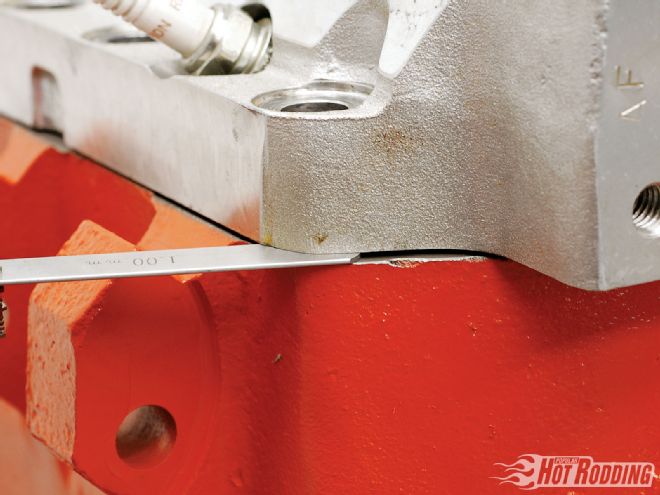 During trial assembly, we noticed that the piston domes hit the cylinder heads and lifted the heads off of the block 0.040 inch.
During trial assembly, we noticed that the piston domes hit the cylinder heads and lifted the heads off of the block 0.040 inch.
All in all, we were very pleased with the power that this combination made on the dyno. 615 hp in a 3,700-pound car would give a 6.1:1 weight-to-power ratio, which is enough power to run low 10s in the quarter-mile at 125 mph. So that is really getting with the program for an engine combination that should be easy to maintain. We haven't had time to get this engine into a car yet for some track duty, but based on the dyno performance we would expect this engine to be a ton of fun on the street. The high compression is the only thing that would put a damper on the street driving, but that can be corrected next time the short-block is freshened up.
Intake Upgrade
Mopar Performance recently introduced a high-rise dual plane intake manifold in their catalog for the 440 engine. The part number for this high-rise intake is 5153525, and it is only available for the 413/426/440 RB engines. This intake is almost identical to an Edelbrock Performer RPM intake, but it has a cool looking Mopar Wedge script cast on the front. We thought it might be interesting to try the Mopar intake on our 505-inch motor while we had it on the dyno, just to see how the new high-rise design stacks up against the older CH-28. We picked a Holley 1,000 HP carb to run on top of the Mopar intake in order to keep the rated cfm similar between the two dyno tests. The 1,000 HP carb has a 1.560-inch venturi with a contoured main body, screw-in air bleeds, and downleg boosters. These HP carbs usually work great right out of the box on a motor like this, and this one was no exception. We made one jet change from 84 to 86 size jets in all four corners, and that was all the tuning we had to do.
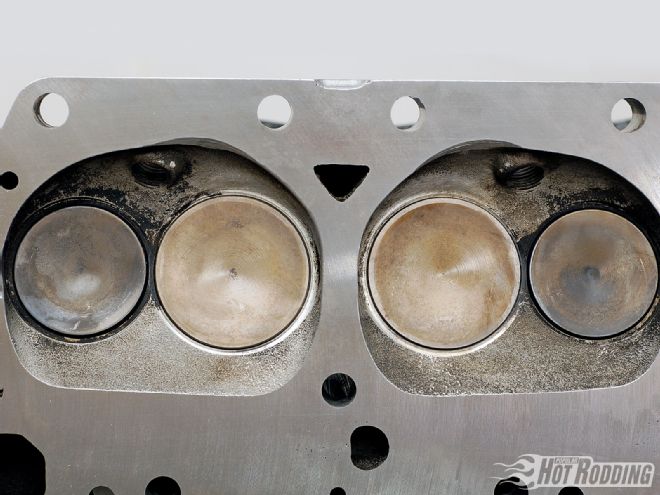 A few moments with a sanding roll created a relief in each combustion chamber to clear the corner of the piston dome. Had we found this interference earlier, we would have laid back the domes on the pistons rather than modify the heads.
A few moments with a sanding roll created a relief in each combustion chamber to clear the corner of the piston dome. Had we found this interference earlier, we would have laid back the domes on the pistons rather than modify the heads.
With the carb dialed in, we pulled the throttle lever and the big motor responded with a best of 630 hp at 5,600 rpm. The torque peak was 630 lb-ft at 4,700 rpm. So the change to a high-rise, single four-barrel intake picked up about 20 lb-ft and 20 hp over the dual-quad setup. That seemed about in line with our previous experiences with the Performer RPM intake manifold design, as it has always made really good power in this rpm range. A Mopar guy can't go wrong with either combination underhood. Both induction systems look great, and they both made excellent power for us.
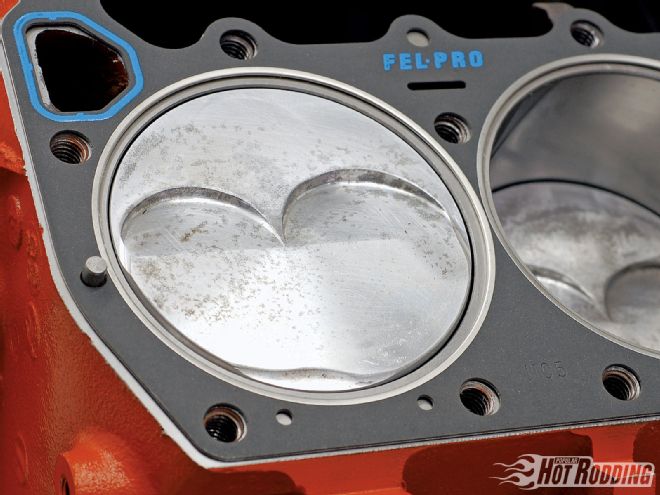 We used the high-performance Fel-Pro 1105 head gasket due to the high compression. This head gasket has a bore diameter that is a little larger than ideal for our bore size, but sometimes you just have to work with the parts that are available.
BY THE NUMBERS
505ci Mopar Big-Block
Bore:
4.350-inch
Stroke:
4.250-inch
Displacement:
505.3 ci
Compression ratio:
12.5:1
Camshaft:
COMP Cams XR292
hydraulic roller
Cam duration:
242/248 degrees
at .050-inch lift
Valve lift:
.584/.579-inch
Rocker arms:
RAS 1.60 ratio
Piston:
Diamond Racing, custom
Block:
'74 passenger car 440
Crankshaft:
440Source.com 4340 forged
Rods:
Scat 6.800-inch Chevy H-beam
Cylinder head:
Edelbrock Performer RPM
Intake valve diameter:
2.140-inch
Exhaust valve diameter:
1.810-inch
Intake manifold:
Edelbrock CH-28
Carburetors:
Edelbrock 1804 AVS (2)
Headers:
Stahl 2x32 dyno headers
Distributor:
MSD billet
Dyno Data
RPM
TQ
HP
3,500
450
300
3,600
459
315
3,700
466
328
3,800
499
361
3,900
514
382
4,000
523
398
4,100
524
409
4,200
534
427
4,300
543
444
4,400
552
463
4,500
564
483
4,600
562
493
4,700
572
512
4,800
611
558
4,900
610
570
5,000
595
567
5,100
601
584
5,200
599
593
5,300
592
598
5,400
585
601
5,500
577
605
5,600
571
609
5,700
561
609
5,800
557
615
5,900
547
614
6,000
535
611
6,100
514
597
We used the high-performance Fel-Pro 1105 head gasket due to the high compression. This head gasket has a bore diameter that is a little larger than ideal for our bore size, but sometimes you just have to work with the parts that are available.
BY THE NUMBERS
505ci Mopar Big-Block
Bore:
4.350-inch
Stroke:
4.250-inch
Displacement:
505.3 ci
Compression ratio:
12.5:1
Camshaft:
COMP Cams XR292
hydraulic roller
Cam duration:
242/248 degrees
at .050-inch lift
Valve lift:
.584/.579-inch
Rocker arms:
RAS 1.60 ratio
Piston:
Diamond Racing, custom
Block:
'74 passenger car 440
Crankshaft:
440Source.com 4340 forged
Rods:
Scat 6.800-inch Chevy H-beam
Cylinder head:
Edelbrock Performer RPM
Intake valve diameter:
2.140-inch
Exhaust valve diameter:
1.810-inch
Intake manifold:
Edelbrock CH-28
Carburetors:
Edelbrock 1804 AVS (2)
Headers:
Stahl 2x32 dyno headers
Distributor:
MSD billet
Dyno Data
RPM
TQ
HP
3,500
450
300
3,600
459
315
3,700
466
328
3,800
499
361
3,900
514
382
4,000
523
398
4,100
524
409
4,200
534
427
4,300
543
444
4,400
552
463
4,500
564
483
4,600
562
493
4,700
572
512
4,800
611
558
4,900
610
570
5,000
595
567
5,100
601
584
5,200
599
593
5,300
592
598
5,400
585
601
5,500
577
605
5,600
571
609
5,700
561
609
5,800
557
615
5,900
547
614
6,000
535
611
6,100
514
597